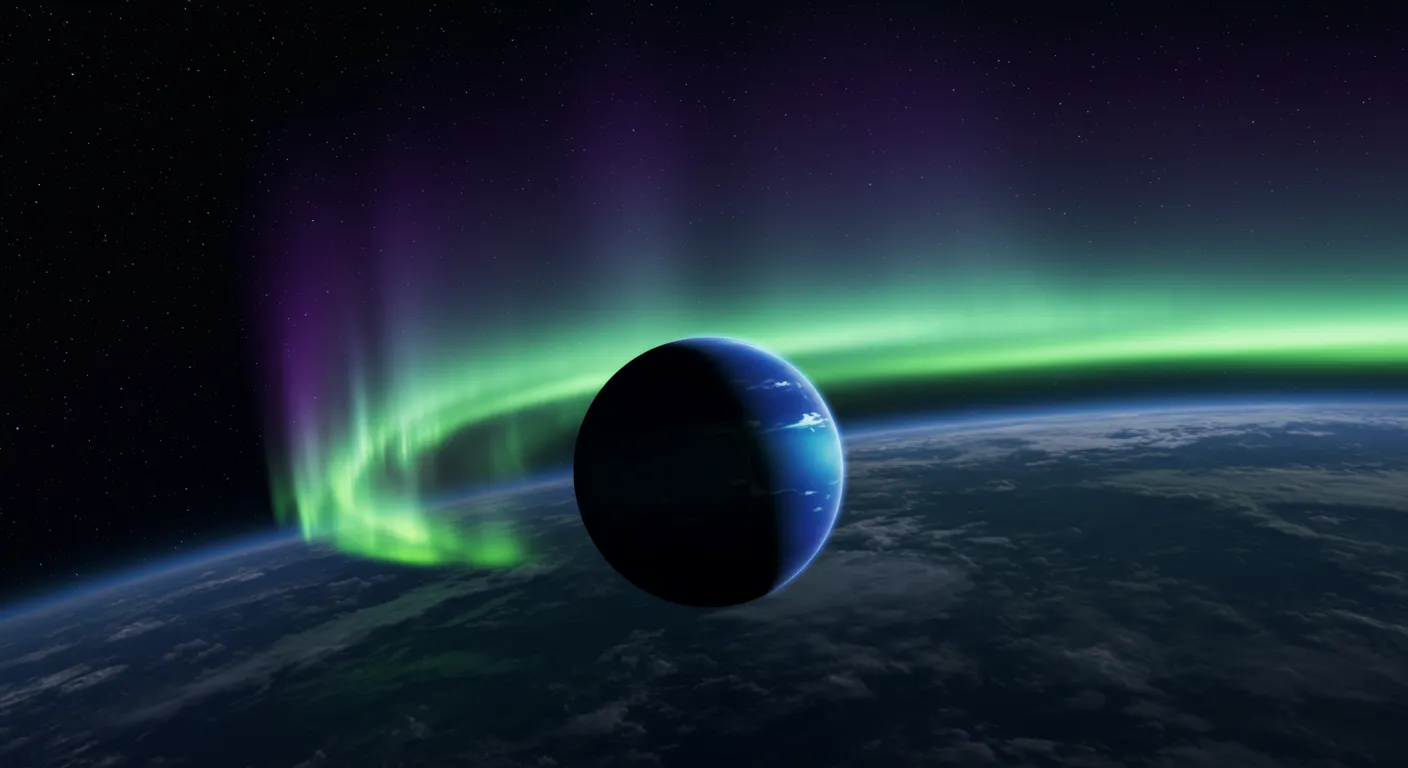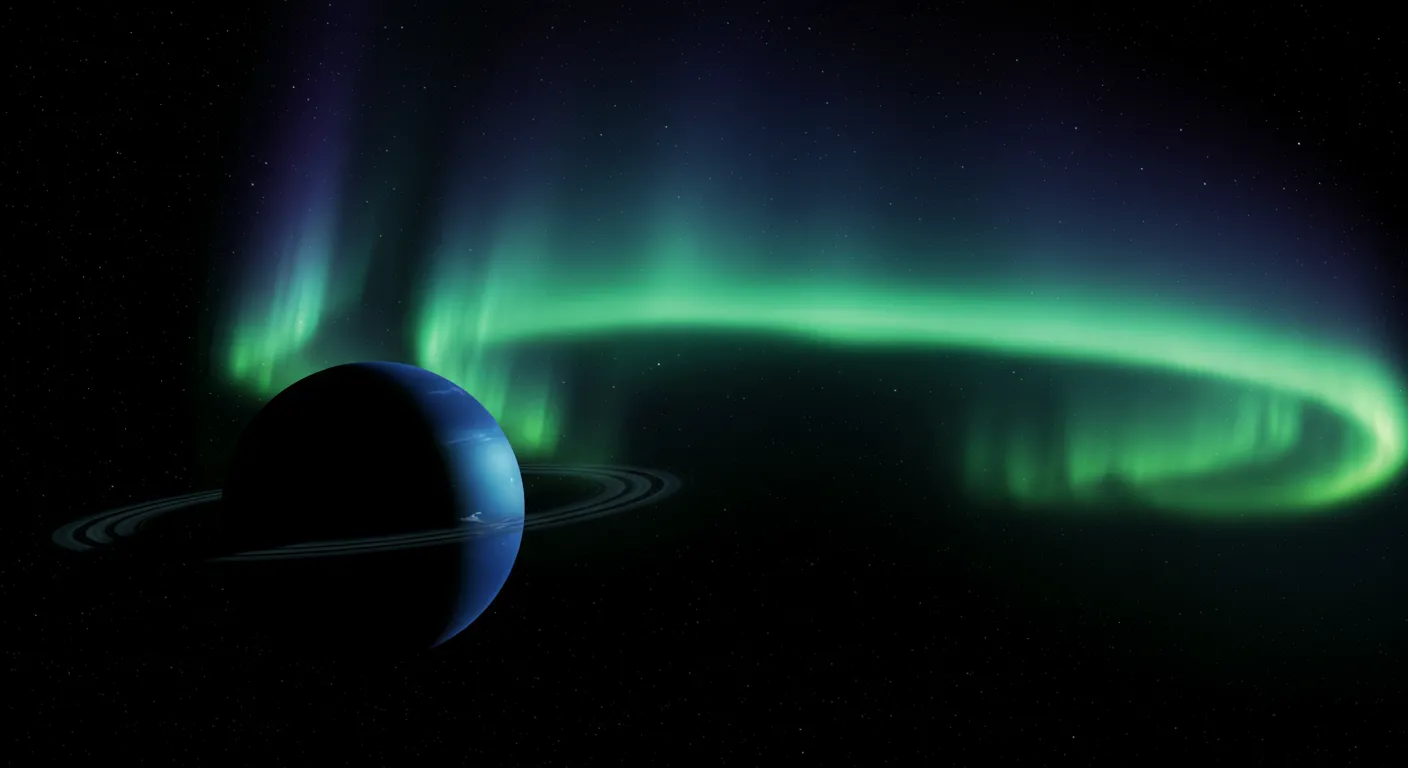Aurora on Neptune: The Mystery of Lights on the Ice-Blue Planet

Aurora on Neptune, a phenomenon long shrouded in mystery, has captivated astronomers with its elusive glow.
Anúncios
For decades, scientists chased hints of these ethereal lights on the solar system’s most distant giant, only to be thwarted by the planet’s faint emissions and extreme cold.
In 2025, the James Webb Space Telescope (JWST) finally unveiled this cosmic spectacle, revealing cyan splotches dancing across Neptune’s mid-latitudes.
This breakthrough not only completes the auroral portrait of our solar system’s gas giants but also raises profound questions about the planet’s bizarre magnetic field and atmospheric dynamics.
Why do these lights, unlike Earth’s polar auroras, shimmer far from the poles?
Let’s dive into the enigma of Neptune’s glow, blending cutting-edge science with imaginative exploration.
A Cosmic Chase Decades in the Making
Picture a detective story spanning 30 years, with astronomers as sleuths hunting an elusive quarry: the aurora on Neptune.
Since Voyager 2’s 1989 flyby, scientists suspected these lights existed, spotting faint traces of activity.
Yet, confirmation slipped through their grasp.
Ground-based telescopes, even the mighty Hubble, couldn’t pierce the veil of Neptune’s chilly atmosphere, which, at -330°F (-201°C), dims emissions to near invisibility.
The breakthrough came in June 2023, when JWST’s Near-Infrared Spectrograph captured the telltale signature of the trihydrogen cation (H3+), a glowing marker of auroral activity.
This discovery, published in Nature Astronomy in March 2025, marked a triumph of technology and persistence, proving that Neptune’s lights were real—and stranger than anyone imagined.
Unlike Earth’s auroras, which crown the poles in vibrant greens and reds, Neptune’s glow defies convention.
It appears at mid-latitudes, roughly where South America sits on Earth, due to the planet’s magnetic field, tilted 47 degrees from its rotational axis.
This tilt creates a chaotic magnetic environment, scattering charged particles in unexpected patterns.
Imagine a cosmic artist splashing paint across a canvas, unbound by rules—Neptune’s auroras are that unpredictable, a testament to the planet’s wild nature.
Why Neptune’s Auroras Were So Hard to Spot
The aurora on Neptune remained hidden for a reason: the planet’s upper atmosphere is a cosmic deep freeze.
JWST revealed a staggering fact: Neptune’s ionosphere cooled by hundreds of degrees since Voyager 2’s measurements, dropping to just 85°C (358 K) in 2023 from 477°C (750 K) in 1989.
This dramatic cooling, a 50% drop in temperature, explains why the auroras emit only 1% of the light they did three decades ago.
Fainter emissions vanish against the backdrop of space, like whispers drowned out by a storm.
This statistic underscores a dynamic atmosphere, shifting faster than solar cycles alone can explain, hinting at internal processes we’re only beginning to understand.
To grasp this, consider a terrestrial analogy: imagine trying to spot a candle’s flame in a blizzard.
Neptune’s cold, hydrogen-rich atmosphere scatters light, while its distance—30 times farther from the Sun than Earth—starves it of solar energy.
Charged particles from the solar wind, which ignite auroras by colliding with atmospheric gases, struggle to produce a visible glow.
Yet, JWST’s infrared sensitivity cut through this cosmic fog, revealing the aurora on Neptune as cyan splotches, a hue evoking the planet’s ice-blue mystique.
+ KELT-9b: The Exoplanet With the Highest Temperature Ever Recorded
The Magnetic Maelstrom Behind the Glow
Neptune’s magnetic field is a riddle wrapped in a storm.
Unlike Earth’s orderly dipole, Neptune’s field is offset from its center and tilted, creating a lopsided magnetosphere.
This quirk drives the aurora on Neptune to mid-latitudes, where charged particles spiral along warped magnetic lines.
Picture a funhouse mirror distorting a laser beam—Neptune’s field bends particle paths into chaotic dances.
This irregularity fascinates scientists, as it may hold clues to the planet’s interior, possibly a churning ocean of liquid methane and ammonia.

To illustrate, let’s invent a scenario: imagine a spacecraft, Aurora Seeker, orbiting Neptune in 2030.
Its magnetometers detect surges in particle activity near the equator, where no aurora should exist.
Scientists on Earth, analyzing the data, realize these surges align with JWST’s cyan splotches, confirming the aurora’s odd placement.
This fictional mission highlights the real challenge: mapping a magnetic field so bizarre it defies models built for Jupiter or Saturn.
The table below summarizes key differences between Neptune’s auroras and Earth’s, highlighting why Neptune’s lights are so unique:
| Feature | Earth’s Aurora | Neptune’s Aurora |
|---|---|---|
| Location | Polar regions (near magnetic poles) | Mid-latitudes (due to tilted magnetic field) |
| Primary Cause | Solar wind particles | Solar wind and possible internal sources |
| Visible Spectrum | Green, red, purple (visible light) | Cyan (infrared, detected by JWST) |
| Atmospheric Driver | Nitrogen and oxygen | Hydrogen and H3+ cation |
| Temperature Impact | Minimal effect on visibility | Extreme cooling dims emissions |
A Window into Neptune’s Secrets
The aurora on Neptune isn’t just a pretty light show; it’s a probe into the planet’s soul.
By studying these emissions, scientists can measure atmospheric composition and temperature, peeling back layers of a world 2.7 billion miles away.
JWST’s detection of H3+ revealed a hydrogen-dominated ionosphere, but its intensity suggests internal heat sources, perhaps geothermal tides from Neptune’s moons.
This raises a question: could these auroras hint at hidden volcanic activity on Triton, Neptune’s largest moon, spewing particles into the magnetosphere?
Consider another original example: a graduate student, Maya, in 2026, uses JWST data to model Neptune’s auroral intensity over a solar cycle.
She discovers spikes in H3+ emissions during solar storms, suggesting Triton’s geysers amplify the aurora on Neptune during peak solar activity.
Her work, though hypothetical, mirrors real research goals—astronomers plan to observe Neptune over an 11-year solar cycle to decode its magnetic and atmospheric interplay.
++ Kepler-7b: The Most Reflective Gas Planet Ever Discovered
The table below outlines potential research avenues unlocked by Neptune’s auroral discovery:
| Research Area | Question | Potential Impact |
|---|---|---|
| Magnetic Field | Why is Neptune’s field so tilted? | Insights into planetary formation |
| Atmospheric Dynamics | What drives rapid cooling? | Understanding ice giant climates |
| Triton’s Role | Do geysers contribute particles? | Clues to moon-planet interactions |
| Exoplanet Analogies | Can auroras signal habitability? | Refining exoplanet detection methods |
Beyond Neptune: Auroras and the Cosmos
What if the aurora on Neptune could teach us about worlds beyond our solar system?
Sub-Neptune exoplanets, common in the galaxy, share traits with Neptune: size, composition, and likely magnetic quirks.
By studying Neptune’s auroras, scientists can predict how magnetic fields shape exoplanet atmospheres, a key factor in habitability.
For instance, strong auroras might strip away atmospheres, rendering planets barren, while weaker ones could preserve conditions for life.
This connection makes Neptune a cosmic Rosetta Stone, translating local phenomena into universal truths.

The discovery also fuels dreams of future missions.
Scientists like Leigh Fletcher, a co-author of the Nature Astronomy study, emphasize the need for infrared-tuned instruments on Uranus and Neptune probes.
Such missions, potentially launching in the 2030s, could map auroral activity in real-time, revealing how solar wind and internal dynamics interplay.
Until then, JWST’s gaze keeps Neptune’s secrets in focus, a beacon for astronomers chasing the unknown.
You can find more information about exoplanets and their atmospheres on NASA’s Exoplanet Exploration.
Engaging the Cosmic Imagination
Why do we chase lights on a planet so far away?
The aurora on Neptune isn’t just a scientific puzzle—it’s a call to wonder.
It reminds us that even in the solar system’s farthest reaches, beauty and mystery collide.
Each cyan splotch is a story of particles, magnetism, and cosmic forces, etched across an ice-blue world.
As we marvel at these lights, we’re not just studying Neptune; we’re glimpsing the universe’s untamed heart.
This discovery, rooted in JWST’s 2023 observations, marks a new chapter in planetary science.
It challenges us to rethink ice giants, magnetic fields, and the delicate dance of light in the cosmos.
So, the next time you gaze at the stars, imagine those distant cyan glows, flickering on a planet that’s finally shared its secret.
Neptune’s auroras are more than lights—they’re a bridge to the infinite.
